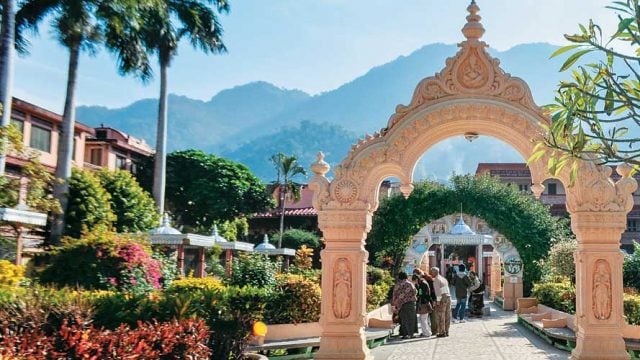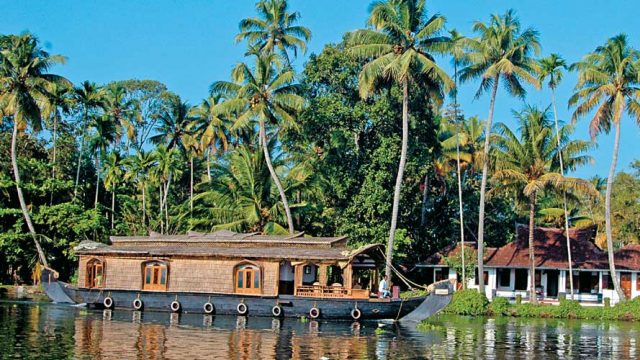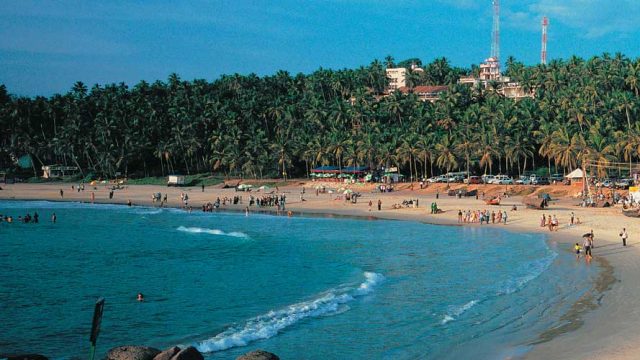Thankfully, every silver lining has a cloud. Not for nothing have they, for centuries in
It is easy to see why National Geographic Traveller would call Kumarakom “one of the ten paradises on Earth”. A hundred and fifty years ago this area was a largely marshy tract, part of the huge Vembanad Lake wetlands eco-system, itself part of the backwaters that connect Kerala’s Kottayam, Kochi and Alleppey districts. Then the king of Travancore granted 500 acres of this wetland to an AG Baker, later to become Kumarakom’s local legend. In much of his watery acreage, Baker reclaimed land, filled the marsh with earth, made embankments for fields, planted mangroves for soil protection, and grew paddy and coconut. Equally significant were the 10 acres in which he did nothing. He kept these for the local and migratory birds that came here, forbidding any disturbance. Today, protected by a thick cluster of mangroves, the Kumarakom Bird Sanctuary, with over 180 species of birds, is a huge attraction. And the little village by the vast lake teems with water and palms, fish and birds, boats and rice, sunset and breeze.

Being in the Kumarakom Lake Resort is a bit like drinking a distillate of all this: beauty, geography, ecological patterns, local circadian rhythms and the immensely rich fun of getting to know an interesting place and its heartbeats. The resort offers all this with impeccable architectural elegance, warm people and blessed quiet (it is suggested to all guests that their mobile phones not be used outside the cottages).
On arrival, like everybody else, I get a freshener towel and Kerala’s favourite ‘traditional welcome drink’ for foreign tourists: coconut water directly from the fruit. After I have drunk this, I proceed to drink even more deeply of the quantities of glowing wood that make up my cottage, set amidst that inimitable Kerala greenery. The room merges into French windows merges into verandah merges into swimming pool, fluidly. The mural on the wall is vibrant. The ‘bathroom’ (and I warn you, this will be a running theme through this feature) is a mini-garden. I have too much dignity to bounce on the bed.
Dignifiedly, I glide over to the lake. Through glimpses of heritage cottages and visions of trees, over a little bridge, past a wooden boat, and near a jetty with a bobbing houseboat, the lake presides, giving meaning to everything. Including the lakeside swimming pool, hammocks, lounge chairs, and the cocktail bar artfully at hand. The sun has perfected its routine over centuries and does a flawless lake-dip every evening. Birds in fluid V- formations fly across to the nearby sanctuary with impeccable timing.
Where’s the Ayurveda, you ask? Well, literally in a 200-year-old building, a Nalukettu (four-sided mansion) belonging to a traditional family of Vaidyas, transplanted here. Set a little away from the cottages, the spa is called Ayurmana and functions under the auspices of two doctors and many therapists. The average tourist may treat it as a spa for occasional ‘relaxing’ massages – albeit one in which you’ve to take off your shoes at the entrance and the oils are not aromatherapy – but Kumarakom also caters to clients who come here for long-term treatments. In keeping with the trends of contemporary life, these treatments are oriented towards weight-reduction, rejuvenation and de-stressing.


After consultation with Dr Baiju Raj, I give myself up to the ministrations of Reeba, who turns out to have magical hands. She and her colleague set out to give me a Patra Podala Svedam, a specialised hour-long treatment. Medicinal herbs and leaves, such as castor leaves in my case, are treated with therapeutic oils, and stuffed in a linen bundle. The bundles are then dipped in hot oil as it simmers away on a stove and rubbed with gentle but thorough friction on the skin, with special attention to the joints. The heat is satisfyingly deep and no inch of skin is left untended. Like most Kerala Ayurveda treatments, this begins with a lulling head massage and ends with a hot bath and shampoo. Till just before the point in Patra Podala Svedam when you drop off into deep sleep, you can actually hear your calves, knees and shoulders weeping with gratitude.
“Waited four years and it was worth the wait,” goes the guest comment of one Ian Salter who seems to have loved his massage as much as I did mine. Later I succumb to an Ayurvedic facial as well, in a perfectly silent room. Fresh papayas and cucumbers dominate the senses for one lovely hour.
In a sleepy-eyed haze I smile my way through the explanation of how the Patra Podala Svedam is a preparatory treatment for the main event since it makes you sweat, how the body has five ‘elements’ and seven ‘dhaatus’ in Ayurvedic understanding, how the oils and materials used at Ayurmana are from Kerala Ayur Pharmacy. Yes…yes…and sweet dreams to you too.
Post-sleep I am taken over by the affable activities manager who encourages me to try my hands, literally, at pottery. In his corner, the potter is ready all day with clay and wheel. He keeps my useless hands on the lump of clay, covers them with his own, spins the wheel and guides me into putting and releasing pressure. Incredibly, I have not corrupted his labours and a pot emerges! They graciously call it a pot I have made. With remnants of mud on my salwar I go off to see the traditional boat-building near the resort. On the way an angelic South African child sees my discoloured salwar and asks her mother: “Mumma, why does the lady mess her pants?”

Later, my belly full of lightly spiced fish (“here in the backwaters, the fish is so tasty because it gets both salty water of the sea and sweet water of the river”) and my head full of how they make such huge boats without using nails, I gravitate to the lake again. It’s past sunset, and the darkening monochromatic world of water, cloud and tree is gathering its secrets to itself. I feel sympathy for myself and my fellow word-vendors and our exhausted phrases that lie gasping among the pages of travel literature: ‘languid lagoons’ and ‘limpid lakes’ trying to survive amid ‘enchanting sunsets’, ‘magical dawns’ and ‘heavenly backwaters’. It’s not our fault, dear reader. The whole ruddy package is mind-bogglingly enchanting, magical and heavenly.
About Kumarakom Lake Resort
The Kumarakom Lake Resort is a heritage resort right on Vembanad Lake, spread over 25 landscaped acres, with transplanted old Kerala cottages and little canals meandering in and out of the property. It belongs to the select group of Small Luxury Hotels of the World and is in its seventh year now. It has been nominated for the Asian Architectural Excellence Award, declared one of the top five luxury hotels in India in 2004 by Incredible India, and called the place for a ‘holiday pamper’ by the Wall Street Journal.
Treatments and Tariffs
■ Individual treatments at Ayurmana come in a range of prices. The massages for relaxation and rejuvenation come for ₹5,000, while the more specialised Ayurvedic massages such as Shirodhara (steady stream of oil on the forehead), Patra Podal Svedam, or Navarakizhi (massage with a linen bag full of medicinal rice) cost ₹5,500 each. Pizhichil (a continuous pouring of warm medicated oil on the body) costs ₹6,500. There’s also a face massage (₹2,000), head massage (₹2,000) and an athletic massage (₹6,000). The facial costs ₹2,500. A 60-minute session of Yoga and Meditation for two costs ₹5,000.
■ Ayurvedic packages are offered for 7, 14 and 21 days. They include: Weight reduction (₹21,500), Rejuvenation (₹21,500), De-stress (₹21,000), Essence of Ayurveda (₹21,500), Arthritis (offered for 7 days, ₹21,500 per night), Panchakarma (offered for 7 days at ₹21,500 per night). All of the rates given here are per-night single occupancy rates.
Tip The rates given here are indicative, taxes are extra.




You can opt for any of these according to email or phone consultations with the spa doctor. You should take the doctor’s advice on the combination that would be ideal for you and may need to send your reports beforehand.
Opting for most of these packages will mean specialised vegetarian diets (sorry meat eaters!), with less oil and spices, and easily digestible food. Some foods do not react well with certain medicines and will be prohibited. The treatment will include medication, and this needs to continue after you leave the resort.
The Ayurmana spa has been given a ‘Green Leaf’ certification by the Department of Tourism and the Government of Kerala, endorsing its requisite standards of quality.
The Therapists
Ayurmana spa is run under the guidance of two friendly and informative doctors: Dr Liji, a graduate of Chennai’s Chandrasekarendra Saraswathi University and Dr Nitin from Mangaluru. There are 16 therapists at the resort.
Accommodation at Kumarakom
Spread across the resort’s 25 landscaped acres are its different kinds of cottages. These are: Old heritage cottages, which are actually transplanted old houses from Kerala villages of which some are lake-view and some are duplex villas; poolside villas (next to a large, semi-private meandering pool), and lakeside presidential suites with a private pool. Each is a pleasure and comes with open-air bathrooms that require a separate ode to them. The elegance of the furnishings and glory of the old wood apart, it’s very relaxing to stroll through the property, with little canals, boats bobbing on them, trees at every step, artefacts strewn around, and always the imminent lake. The main swimming pool is bang on the lake, hammocks and palms sway with equal grace, and the waters are very soothing. The prices, however, are not. Some indicative prices are given below but rates differ quite sharply according to season.
In the summer (June 1–September 30), the costs would be: Meandering Pool Villa (₹15,500); Heritage Lake View Villa with pool (₹17,500); Presidential Suite (₹50,000).


Winter is season time and costs more. The same accommodation in normal season (October 1–December 19) and peak season (December 20–January 10) would cost you Meandering Pool Villa (₹20,500/ ₹34,500); Heritage Lake View Villa with pool (₹23,500/ ₹38,500); Presidential Suite (₹65,000/ ₹85,000).
The resort offers a host of activities that are included in the package. The nicest of these is a sunset cruise every evening, in which you are taken some way in to the Vembanad Lake on a boat and then, as the sun sets, treated to a mid-water flute concert. There is also Yoga, pottery and mat-weaving, cycling, fishing, village walks, cultural programmes, a dip in the swimming pool, health club and indoor games. You can have a speedboat ride for ₹2,500 per hour (plus taxes) and a backwater cruise for ₹2,400 per hour (plus taxes). Fair warning, the boat rides are subject to availability.
Meals at Kumarakom
At the Ettukkettu restaurant, the resort offers buffet meals, which are included in the price of the room. A variety of cuisines are served – Thai, Chinese, Continental and several Indian styles. My favourite was the Naadan Kerala cuisine. There was some exceptional fish; the banana-leaf wrapped karimeen and chemeen curry is to die for! The vegetarian food was as interesting and tasty as the non-vegetarian fare.
When people come for specific Ayurvedic packages, the doctor prescribes certain food-related do’s and don’ts for them which are communicated to the restaurant. Special food can then be taken accordingly. The Ettukkettu buffet is such that you can skip all you are not allowed to eat and still be left with some choice.
The restaurant also serves complimentary tea/ coffee and snacks between 4.00pm and 6.30pm in pleasant open-air surroundings at Thattukada.
Souvenirs
The curio shop at the resort offers a mish-mash of what may interest the tourist, from Auroville handcrafted soaps, beautifully packed incense sticks, sandal collection, coconut shell jewellery and books on Kerala. The best pick of the lot, however, are the knick-knacks the resort has picked up from the old properties in Kerala, from old bottles to brass lamps to pots and ceramic plates.
AROUND KUMARAKOM LAKE RESORT
Kumarakom Bird Sanctuary (2km)
Set on the banks of the Vembanad Lake, the Kumarakom Bird Sanctuary is said to host around 180 species of birds, local and migratory. When AG Baker was developing this marshy area for agricultural purposes in the mid-19th century, he kept aside some 10 acres of land for the birds. The Kerala government declared this a bird sanctuary in 1989.
The sanctuary is a stone’s throw away from the resort. It can be reached on foot, or on cycles, or the resort can organise your trip.
It is ideal to go early in the morning at about 6.00am to catch sight of the birds. There are numerous varieties of birds here, such as the Northern pintail ducks, owls, moorhens, cormorants, darters, Brahminy kites, waterfowl, egrets and heron. A variety of birds such as teal, parrots, flycatchers and larks also migrate to this sanctuary during certain months. If you journey here in the winter you might be lucky enough to catch the migratory Siberian crane. A highly endangered species, there are only a few thousand of the cranes left in the world.
It’s best to take a boat on the lake for a good experience. A resort organised trip costs approximately ₹700 per car.
GETTING THERE
Air Nearest airport: Nedumbassery Airport (124km/ 2.5hrs), north of Ernakulam, offers connections to all metros and several major cities, such as Delhi, Chennai, Mumbai, Bengaluru, Kolkata and Hyderabad. Ambassador or Indica taxis are available for ₹4,000– 4,500. The resort organises pick-up for ₹6,500 (one way)
Rail Nearest railhead: Kottayam (15km/ 20mins). The resort can organise a pick-up will cost you around ₹2,000 one way. A taxi will cost between ₹1,000 and ₹1,400
Road It is difficult for a newcomer to navigate the backwater roads leading to KLR. Hire a cab with a driver who knows the area
Ayurveda
Kerala
Vembanad lake





